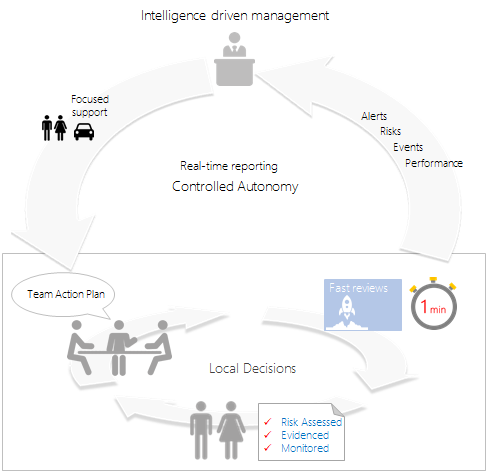Challenges
Typically sized at 40 to 75 staff, larger organisations should be on top of most routine things.
At this level, the focus has shifted to having comprehensive systems to collect data from a large number of sources and collate these into meaningful evidence.
Under the new CQC regime, the inspection will change gear to Well-Led as a primary concern.
For management, this means that there will be more emphasis on demonstrating leadership and management capability with Compliance Planning and Monitoring.
Evidence such as records of regular meeting and internal audits will take centre stage in proving you are Well-Led.
What you need
Most enterprises are likely to have all the compliance and training systems in place.
The bigger challenges will be Business Intelligence that transforms the way the organisation operates and reacts to potential challenges.
Digital transformation will be key, and the challenge of moving away from paper and simple intranets to performance management systems cannot be underestimated.
Here are some typical challenges:-
- Real-time performance monitoring
- Ability to deliver knowledge instantly to every staff level
- Performance Measurement
- Systemic failures - prediction and intervention
- Converting to digital world from paper
Case Study in Appraisals
A typical staff appraisal system is geared more towards HR goals of employment, promotion, and salary.
Paper or document based systems, even when constructed on an online database, are geared towards narrative style assessments, which do not lend themselves to analytics,
Such systems are less likely to signal systemic risks and the information remains trapped in the HR department. Their focus is not on corporate risk, and so high level weaknesses that may affect the enterprise may go undetected.
An alternative approach: How we converted staff appraisals into a digital goldmine:-
- Each Appraisal collects over 60 risk points
- Staff carry out detailed risk assessments without realising it
- Datasets of everything from basic competency to confidence levels
- Data for general competency and job/specialism specific
- Analytics allow predictive analysis of failure points
- Detects and pinpoints systemic weaknesses for proactive intervention
- Trend-watch with long term historical analytics
Business Intelligence
When the system tells you that 20% of your staff indicated weak confidence in the subject of 'Confidentiality'
